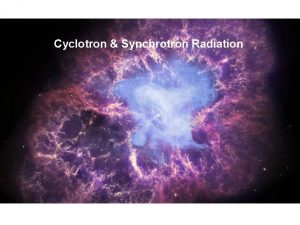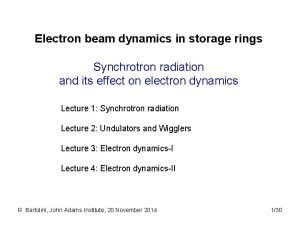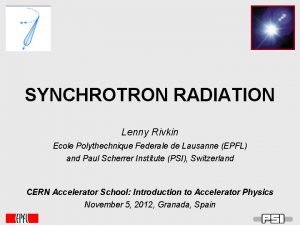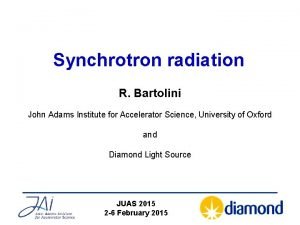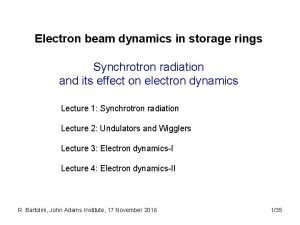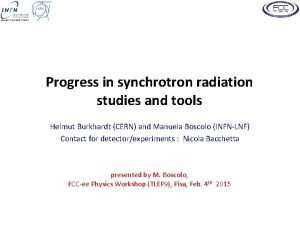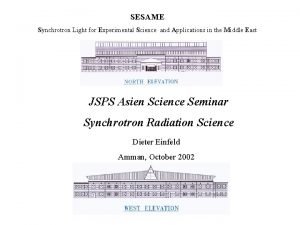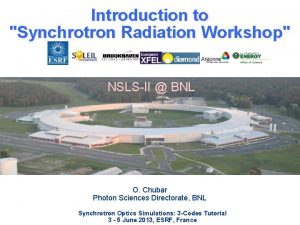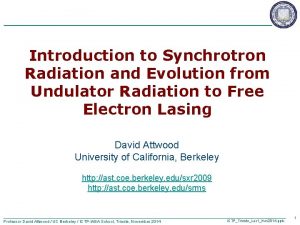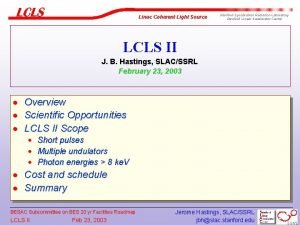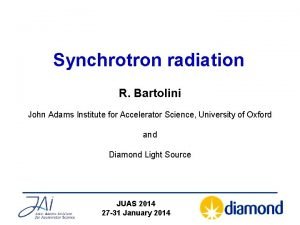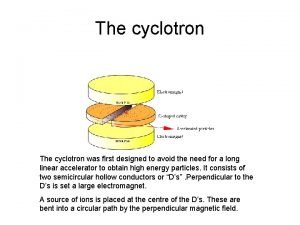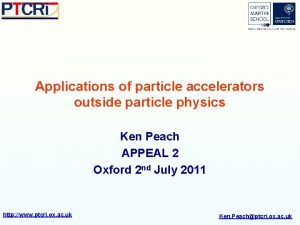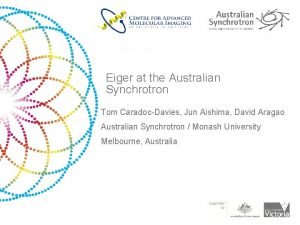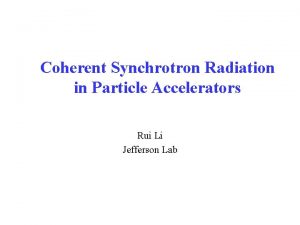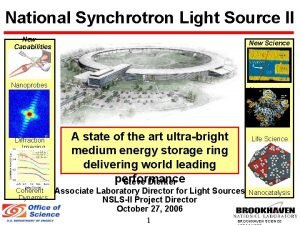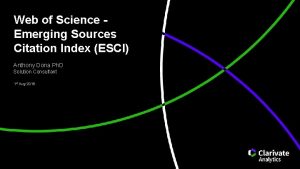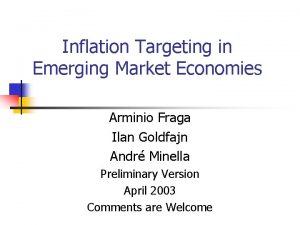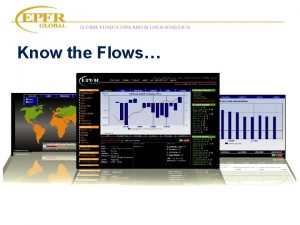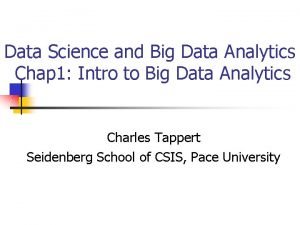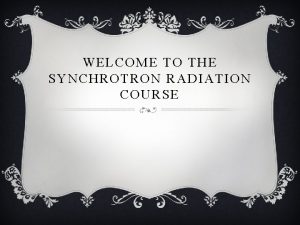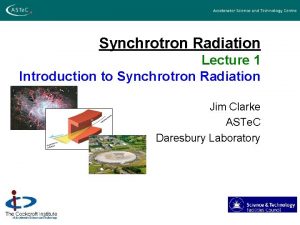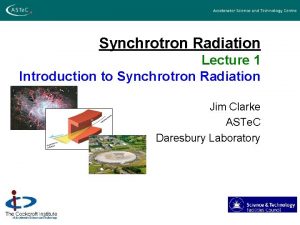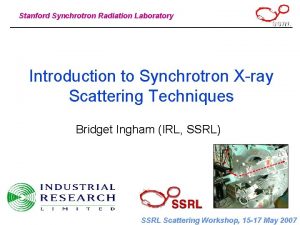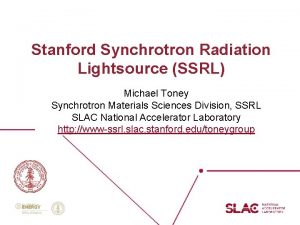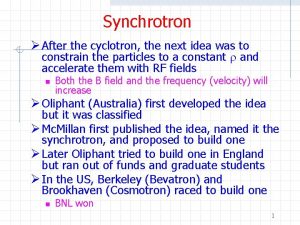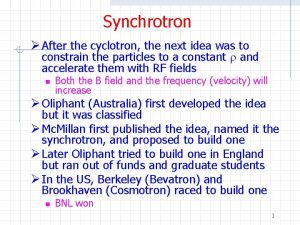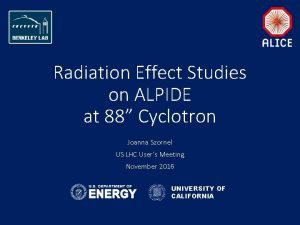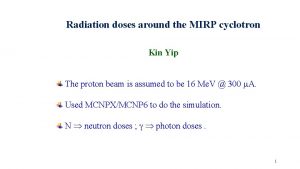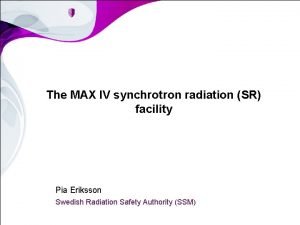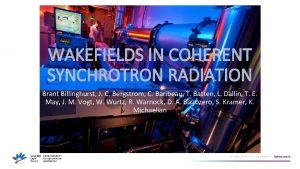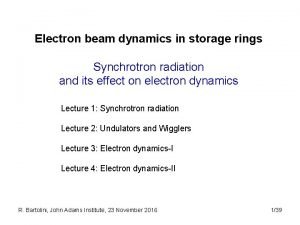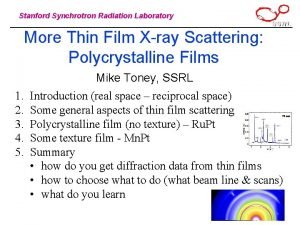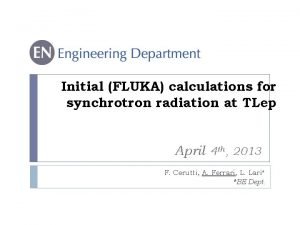Cyclotron Synchrotron Radiation Synchrotron Radiation is radiation emerging










































































- Slides: 74

Cyclotron & Synchrotron Radiation


Synchrotron Radiation is radiation emerging from a charge moving relativistically that is accelerated by a magnetic field. The relativistic motion induces a change in the radiation pattern which is very collimated (beaming, see Lecture 3).

Cyclotron Radiation: power & radiation pattern To understand synchrotron radiation let’s first begin with the non-relativistic motion of a charge accelerated by a magnetic field. That the acceleration is given by an electric field, gravity or a magnetic field does not matter for the charge, which will radiate according to the Larmor’s formula (see Lecture 3) Direction of acceleration Radiation pattern Remember that the radiation pattern is a torus with a sin^2 dependence on the angle of emission:

Cyclotron Radiation: gyroradius So let’s take a charge, say an electron, and let’s put it in a uniform B field. What will happen? The acceleration is given by the Lorentz force. If the B field is orthogonal to v then: Equating this to the centripetal force gives the “Larmor radius”: We can also find the cyclotron angular frequency:

Cyclotron Radiation: cyclotron frequency From the angular frequency we can find the period of rotation of the charge: Note that the period of the particle does not depend on the size of the orbit and is constant if B is constant. The charge that is rotating will emit radiation at a single specific frequency: Direction of acceleration Radiation pattern

Cyclotron Radiation: power spectrum Since the emission appears at a single frequency and the dipolar emission pattern is moving along the circle with constant velocity, the electric field measured will vary sinusoidally and the power spectrum will show a single frequency (the Larmor or cyclotron frequency). Radiation Pattern Electric Field E(t) Power Spectrum P(nu) Cyclotron frequency

Cyclotron Radiation: kinetic energy Suppose now you have a charged particle, say a proton, with a kinetic energy of 1 Me. V. The definition of electronvolt e. V is the following: the amount of energy an charge gains after being accelerated in an electric potential of 1 Volt ( 1 Volt ~300 stat. Volt in cgs units). Both an electron and a proton gain the same energy by definition, but of course the mass of the proton is ~2, 000 times larger than the electron’s, thus its velocity is way smaller. (An implication for this is that protons need to be much more energetic than electrons to become relativistic). Let’s put this velocity v back into the Larmor radius’ formula: (q = 1. 6 e-19 C; m = 1. 67 e-27 kg; V = 1, 000 V; B = 1 T) So if I have a 1 Me. V proton, and a B field of say, 1 T (1 Tesla = 10^4 G) then my Larmor radius is: 15 cm. What will happen if you have a 1 Me. V electron in the same field?


The “square wave” in the plot in the slide before means that you can apply a varying electric field so that it changes only sign (that’s the meaning of the square wave). How often do you need to change the sign of the electric field to accelerate the proton? You need to change the field twice every period: Therefore you need to put an alternating electric field with a square wave at a frequency of 30 MHz

In 1977 German astronomer J. Trumper identified a cyclotron emission line in the accreting pulsar Hercules X-1. The X-ray spectrum shows an emission line at around 55 ke. V. Trumper proposed that the hot electrons around the neutron star magnetic poles are rotating around a strong B field of 5 e 12 Gauss, giving rise to an emission line at around 55 ke. V.

Hercules X-1: Geometry

Relativistic Case: From Cyclotron to Synchrotron We now drop our assumption that v<<c (non relativistic particles) and we describe what happens to the radiation of a charge accelerated in a B field when the speeds approach c. For this is important that you review Lecture 3 on relativistic effects. Let’s start by remembering the Lorentz transformations of time: Then remember that the frequency is 1/time, so a frequency transforms as: Therefore what we have called the Larmor frequency and radius become now the so-called gyration frequency and gyration radius: The period of rotation therefore is: The period now does depend on the particle velocity (Lorentz factor gamma) and as the velocity approaches c, the period increases.

Relativistic Case: From Cyclotron to Synchrotron We now drop our assumption that v<<c (non relativistic particles) and we describe what happens to the radiation of a charge accelerated in a B field when the speeds approach c. For this is important that you review Lecture 3 on relativistic effects. Let’s start by remembering the Lorentz transformations of time: Then remember that the frequency is 1/time, so a frequency transforms as: Therefore what we have called the Larmor frequency and radius become now the so-called gyration frequency and gyration radius: The period of rotation therefore is: The period now does depend on the particle velocity (Lorentz factor gamma) and as the velocity approaches c, the period increases.

The term synchrotron might now become clear: in synchrotron machines, the strength of the B field is not kept constant, but it is increased with time so that as gamma increases the frequency and the radius of gyration are constant. Synchrotron facilities are widespread and have very different uses. The most famous one is perhaps the Large Hadron Collider, which is a synchrotron machine used to generate relativistic protons up to 7 Te. V in energy (per beam). In this case the synchrotron radiation represents an “annoying” energy loss. All the magnets on the LHC are electromagnets. The main dipoles generate powerful 8. 3 T magnetic fields (Earth’s magnetic field is ~0. 00005 T). The electromagnets use a current of 11, 080 Amp to produce the field, and superconductive material allows the high currents to flow without losing any energy to electrical resistance.

Example: Large Hadron Collider LHC accelerates protons in 5 stages. Stage 1: Linear Accelerator Energy: 50 Me. V Speed: 1/3 c Stage 2: Proton Synchrotron Booster Circumference: 160 m Energy: 1. 4 Ge. V (mc^2> p rest mass) Speed: 0. 92 c Stage 3: Proton-Synchrotron Circumference: 620 m Energy: 25 Ge. V Speed: 0. 99935 c LHC 8 T magnetic fields require a current of 11, 000 Amp!!! To sustain such huge currents, the resistance of the conductors need to be zero → superconductors. Comparison: an airplane jet engine requires 1, 000 Amp Your house is not using more than 100 Amp. Stage 4: Superproton Synchrotron Circumference: 7 km Energy: 450 Ge. V Speed: 0. 999993 c Stage 5: LHC Circumference: 27 km Energy: 7 Te. V Speed: 0. 9999 c

Synchrotron Radiation in Astrophysics Magnetic fields and relativistic particles are plentiful in astropysics. Synchrotron emission is seen in a wide variety of environments. Note: From here onward I switch back to cgs units

Synchrotron Radiation: Emission Pattern Take a relativistic electron moving around a B field. To understand how the radiation pattern changes from cyclotron to synchrotron we can do the following: - we start with the radiation pattern in the electron rest frame (where we know the radiation pattern) - then we do a Lorentz transformation from the rest frame to the lab frame.

Synchrotron Radiation: Emission Pattern Take a relativistic electron moving around a B field. To understand how the radiation pattern changes from cyclotron to synchrotron we can do the following: - we start with the radiation pattern in the electron rest frame (where we know the radiation pattern) - then we do a Lorentz transformation from the rest frame to the lab frame. Note: you might argue that the electron in the rest frame is not really at rest since it is accelerating. This is true, but at least for infinitesimal neighboring times the particle will be non-relativistic and you can use Larmor’s formula.

Synchrotron Radiation: Emission Pattern To transform the radiation pattern what we really need is to transform the emission angle theta and see how it changes under Lorentz transformations. But we have already seen this in Lecture 3: aberration of light

Synchrotron Radiation: Power In the case of cyclotron, as well as (non-rel) Bremsstrahlung we saw that we can use the Larmor’s formula (Lecture 3) to calculate the power emitted by an accelerated charge: First, let’s take the usual rest frame K’ with velocity v and the lab frame K. Power is energy over time. Let’s Lorentz transform energy and time. Energy: Time: Therefore: So the total power emitted will be a Lorentz invariant (but this does not mean that the angular dependence of radiation will be the same of course).

Synchrotron Radiation: Lorentz Transformation of Accelerations The Larmor’s formula in a non-relativistic reference frame is: It is now convenient to split the acceleration in its parallel and perpendicular components to the direction of the rest frame v. In Lecture 4 we saw how velocities transform. Now we see how accelerations transform. As usual start with the Lorentz transformations of coordinates and velocities (Lecture 4): where we have defined for convenience:

Therefore: And a similar result holds for the z-component. Now, if the particle is at rest instantaneously in K’, then the velocity Also, sigma = 1 in this case. Therefore, take the velocity v along the x-axis and from the equations above:

So take now a helical path of a particle in a uniform B field. Let’s decompose the velocity and accelerations into their parallel and perpendicular components and write the total emitted power: Now from this formula one might suppose that the parallel component is more important than the perpendicular one. This is true when the two accelerations are comparable. But think for a moment about what happens in a ultra-relativistic beam of particles. If v~c, you cannot really accelerate the particle in the direction of v (the parallel component) whereas with a modest B field you can strongly bend the direction of motion and have a large perpendicular acceleration. So for ultra-relativistic particles the parallel component gives almost zero contribution!!!

Synchrotron Radiation: Power and Pitch Angle Since we know the angular frequency of radiation (gyrofrequency): Substituting this back in the emitted power equation we get: However, if we have many particles, each of them will have a different pitch angle alpha. So the perpendicular velocity needs to be averaged over all pitch angles. If we do that, we can write the formula: and rewrite it as: Where is the Thomson cross section and is the magnetic energy density.

IMPORTANT: The formula written before is valid only for electrons emitting synchrotron radiation. The reason why we write this formula only for electrons is because in basically all astrophysical cases you have electron synchrotron. This is because electrons become relativistic much more quickly than protons as they are easier to accelerate. However using the preceding expression (with the red contour in the previous slide) is fine for any particle of mass m and charge q. Example: Suppose the protons of the LHC are accelerated up to an energy of 7 Te. V and then they are left to cool down due to synchrotron emission. On which timescale do they cool down? Proton energy: 7 Te. V → velocity v~ 29979245800*0. 9999 cm/s B = 80, 000 G q = 4. 8 e-10 stat. C gamma ~ 7, 000 m = 1. 67 e-24 g Timescale = (Proton energy) / (synchrotron power) = 10 erg/ 4. 9 e-5 erg/s = 2. 5 days Now let’s do the same calculations for a 7 Te. V electron (gamma ~ 13, 000): Timescale = (Electron energy) / (synchrotron power) = 10 erg/ 4. 9 e-5 erg/s = 9 ns Electrons would cool down a factor 10^13 faster than protons!! → LHC INFEASIBLE at 7 Te. V

Synchrotron in Astrophysics Astrophysical jets are most likely generated by relativistic particles being launched close to a black hole (or even a neutron star when in a binary). Such particles are thought to be electron/positron pairs which then spiral along B field lines and generate synchrotron radiation. However, we also know that cosmic rays most likely come from Active Galactic Nucei, where strong B fields around supermassive black holes launch streams of ultra-relativistic particles which include protons. So it’s still unclear whether jet emission is due to leptons or hadrons.

Synchrotron Radiation: Jupiter’s Belt

Synchrotron Radiation: Single Particle Spectrum It’s important now to make a distinction between the emitted radiation and the received radiation. Indeed the received radiation will be such that the observer can see it only when the narrow beam points towards the observer. This will be a fraction much smaller than the gyration period! The electro(magnetic) field received by the observer will thus be pulsed and therefore it must be composed by many frequencies (think about the Fourier power spectrum of a narrow pulse…). How small is this period of time? First of all, suppose that we have one electron and the pitch angle is 90 degrees. The electron will radiate towards the observer only for a brief amount of time: Now a question: here we are seeing photons. The expression above is the emission time. What happens when we measure time intervals with photons? Do we have the same result as when we measure time intervals with clocks? (Lecture 4)

Synchrotron Radiation: Single Particle Spectrum In Lecture 4 we saw that: Here therefore it must be the same with the difference that theta here is ~0 because we are emitting photons in the same direction of motion: We can write: The inverse of this is an angular frequency. We can thus build a characteristic synchrotron frequency in this way:

Synchrotron Radiation: Single Particle Spectrum First thing to note: this frequency is gamma^3 larger than the gyration frequency. This makes sense since we see the emission only for a tiny fraction of the orbit, whereas the gyrofrequency reflects the whole circular motion of the electron. Second: the observed electric field of the rotating charge will be narrow and thus the radiation will spread across many frequencies. The characteristic frequency where the power will drop is of the order of the synchrotron frequency above. The width of the electric field is ~

Cyclotron radiation The charge is moving in a circle, so the electric field variation is sinusoidal Cyclotron-synchrotron radiation The charge is moving in a circle, but some aberration of light starts to become visible Synchrotron radiation The charge is moving in a circle, aberration of light is extreme and radiation is seen only for a tiny amount of time when the cone 1/gamma points towards the observer

Synchrotron Radiation: Single Particle Spectrum The fact that the single particle spectrum is not a single frequency can be easily understood by using Fourier transforms. This is related to the so-called time-energy uncertainty relation. Another way is to think about this is a wave packet localized in time.

Waves and Fourier Transforms (Section 2. 8 R&L) The spectrum of radiation depends on the time variation of the electromagnetic field. If you observe the variation of, say, the electric field E(t) for a time Dt then you can define the spectrum with a frequency resolution Domega = 1/Dt. Fourier Transform Inverse Fourier Transform

Relation between Power and Fourier Transforms Suppose you have a sinusoidal electro-magnetic field. We know that the average magnetic and electric fields are B = E/c Therefore the Poynting vector is: The total energy per unit area in the pulse is:

Relation between Power and Fourier Transforms Suppose you have a sinusoidal electro-magnetic field. We know that the average magnetic and electric fields are B = E/c Therefore the Poynting vector is: The total energy per unit area in the pulse is:

Fourier Transforms Now we take the Fourier Transform:

Fourier Transforms

Synchrotron Radiation: Single Particle Spectrum In summary: We haven’t derived in a rigorous way the single particle spectrum yet, but we can expect the following. 1. The power spectrum will show a broad range of frequencies 2. The width of the power in the power spectrum will be of the order of 3. We can expect a quick (exponential) cutoff above these frequencies. 4. The peak of the power must be somewhere around too, since most of the power is emitted in the interval 5. We expect much more than half of the power to be emitted within 1/gamma. For point 5. please check Lecture 3 where we showed that

Synchrotron Radiation: Single Particle Spectrum First thing to note: this frequency is gamma^3 larger than the gyration frequency. This makes sense since we see the emission only for a tiny fraction of the orbit, whereas the gyrofrequency reflects the whole circular motion of the electron. Second: the observed electric field of the rotating charge will be narrow and thus the radiation will spread across many frequencies. The characteristic frequency where the power will drop is of the order of the synchrotron frequency above. The width of the electric field is ~

Synchrotron critical frequency (definition)

Synchrotron Cooling Time Once we have the total emitted power we can easily calculate the cooling time of an ensemble of electrons emitting synchrotron. As an example, take a supermassive black hole in an Active Galactic Nucleus. The magnetic field around the black hole is typically of the order of 1, 000 G The Lorentz factor is also of the order of 1, 000, so the electrons cool down on a timescale of just 0. 77 seconds. If instead you calculate the same cooling time very far away from the black hole, where gamma is still 1, 000 but the B filed is much smaller (e. g. , B~1 e-5 G), the cooling time is then of the order of 250 Myr.

Synchrotron Cooling Time The galaxy in the center is Cygnus A, at a distance of 260 Mpc. This image is taken in optical where the source is not particularly remarkable. It is a very famous source especially for its low-energy emission.

Synchrotron Cooling Time The red light is radio emission from synchrotron radiation in the so-called radio lobes. These are the end regions of powerful jets generated in the center of the galaxy around a supermassive black hole of mass of the order of 1, 000, 000 Msun.

Synchrotron Single Particle Spectrum For reasons of time we do not derive the expression of the power emitted by a single particle. First let’s define the quantity . Then the function F(x) is: This function F(x) contains the frequency dependence of the synchrotron power of the single particle. is the Bessel function of oder 5/3. The function F(x) admits two asymptotic limits, one at low frequencies x<<1 and one at high frequencies x>>1.

Asymptotic limits

Peak Frequency Critical Frequency Why this synchrotron emission (SINGLE electron) is not a single frequency?

Fourier Transforms

The spectrum of a single particle has its broad shape for two reasons: 1. The electro-magnetic field is not sinusoidal 2. The duration of the “pulse” is finite in time This is a general property of any signal.

1. The single-particle spectrum extends up to something of the order of the critical frequency before decreasing exponentially. 2. The peak of the singleparticle spectrum occurs at 0. 29 x critical frequency 3. The width of the peak is of the order of the critical frequency 4. The meaning of the low frequency power-law index “ 1/3” is not immediately obvious and we will skip its detailed derivation here (see Section 6. 4 on R&L).

We know how the spectrum of one particle emitting synchrotron will look like. What if we have an ensemble of particles (with energies E between E 1 and E 2)? (C is a constant that depends on the pitch angle) We choose a power-law distribution because this is a very common case in many different physical, biological and other natural (and man-made) phenomena.


x (Convolution )

The total power emitted at a specific frequency by our ensemble of (power-law distributed) particles is: We substitute the frequency omega with the variable x: Remember also that the critical frequency is proportional to gamma^2

It's important to note that the function F(x) contains the dependence of the magnetic field (since the critical frequency depends on the magnetic field) Therefore we expect that the total power emitted depends on the frequency but also on the magnetic field. After some algebra (read section 6. 4 if interested) one finds: where we have defined the spectral index s = (p-1)/2

Power Synchrotron: A power law electron energy distribution produces a power law spectrum

Self-Absorption If you noticed, we superimposed different single particle spectra and we said that the initial power-law distribution of electrons (spectral index “p”) gives a power law distribution of emitted radiation (spectral index “s”). However, according to the principle of detailed balance (see Lecture 1 and 2), to every emission process there is a corresponding absorption process – in the case of synchrotron radiation, this is known as synchrotron self-absorption. Therefore this power-law with spectral index “s” cannot be the whole story. . . When does (self)-absorption occur?

Synchrotron Self-Absorption After some algebra, that we will skip here, one finds: We can write the source function as usual: Why in this case the slope of the self-absorbed part is 5/2, whereas for thermal bremsstrahlung it was 2?

Synchrotron Self-Absorption After some algebra, that we will skip here, one finds: We can write the source function as usual: Note that the slope is NOT 2 as in the Rayleigh-Jeans regime, but it’s 5/2. The reason is simple: here we do not have (and cannot have) a thermal distribution of particles since the B field prevents this to happen.


Observations of the thin part can be used to determine K and s With the observation of the self-absorbed part you can determine B

Observations of the thin part can be used to determine s With the observation of the self-absorbed part you can determine B Self absorption frequency: marks the transition from optically thin to thick

THICK Self absorption frequency: marks the transition from optically thin to thick THIN

Thermal Bremsstrahlung Blackbody Synchrotron

Thermal Bremsstrahlung Blackbody Synchrotron What happens here?

The Crab Nebula (M 1)

In the Crab nebula, spiraling electrons emitting optical photons have a lifetime of only ∼ 100 yr, and those emitting X-rays live only a few years. Such electrons could not have been accelerated in the 1054 CE supernova collapse that spawned the Crab nebula. Their energy source was a puzzle until the discovery of the Crab pulsar in 1968.


Chandra X-Ray Observatory (0. 3 -8 ke. V) Hubble Space Telescope (Optical)


Very easily visible from thethe Netherlands!! Where is “visible” here? (Today after ~11 pm) Mag. ~ 7. 5 20 -cm telescope

Very easily visible Mag. ~ 7. 5 You can “see” some synchrotron here! 20 -cm telescope


Summary of Radiation Properties Optically thick Thermal Blackbody Bremsstrahlung Synchrotron Inverse Compton – YES NO – Maxwellian distribution of velocities YES – NO Relativistic speeds – – – YES Main Properties Matter in thermal equilibrium Matter AND radiation in thermal equilibrium Radiation emitted by Radiation emitted accelerating particles by accelerated particles in B field. Rules of thumb: 1. Blackbody is always thermal, but thermal radiation is not always blackbody (e. g. , thermal Bremsstrahlung) 2. Bremsstrahlung can be thermal or non-thermal. 3. Bremsstrahlung becomes blackbody when optical depth >>1. 4. Synchrotron emission exists only for non-thermal distribution of particles
 Synchrotron radiation
Synchrotron radiation Synchrotron radiation
Synchrotron radiation Bsrtm
Bsrtm Lenny rivkin
Lenny rivkin Synchrotron radiation
Synchrotron radiation Synchrotron radiation
Synchrotron radiation Synchrotron
Synchrotron Synchrotron
Synchrotron Felexit
Felexit Synchrotron radiation
Synchrotron radiation Linear accelerator stanford
Linear accelerator stanford Synchrotron radiation
Synchrotron radiation Cyclotron
Cyclotron Cyclotron
Cyclotron Uc davis cyclotron
Uc davis cyclotron Cyclotron diagram
Cyclotron diagram Cyclotron
Cyclotron Formula of cyclotron
Formula of cyclotron Baby cyclotron
Baby cyclotron Psi synchrotron
Psi synchrotron Synchrotron
Synchrotron Synchrotron
Synchrotron National synchrotron light source ii
National synchrotron light source ii Swinburne emerging leader
Swinburne emerging leader Clarivate esci
Clarivate esci The byzantine empire and emerging europe answer key
The byzantine empire and emerging europe answer key Emerging markets inflation
Emerging markets inflation Adolescence and emerging adulthood a cultural approach
Adolescence and emerging adulthood a cultural approach Trish livingston deakin
Trish livingston deakin Emerging infectious diseases
Emerging infectious diseases Postformal thought
Postformal thought Emerging adulthood psychosocial development
Emerging adulthood psychosocial development Nigeria newly emerging economy
Nigeria newly emerging economy Challenges of international business in emerging markets
Challenges of international business in emerging markets Dubai emerging market
Dubai emerging market Emerging memory technologies
Emerging memory technologies Soft trends in software engineering
Soft trends in software engineering Emerging technology chapter 2
Emerging technology chapter 2 Nacada emerging leaders program
Nacada emerging leaders program Emerging trends meaning
Emerging trends meaning Emerging database technologies and applications
Emerging database technologies and applications The hidden risks in emerging markets
The hidden risks in emerging markets Renaissance emerging markets fund
Renaissance emerging markets fund Emerging technology synthesis
Emerging technology synthesis Chapter 5 it infrastructure and emerging technologies
Chapter 5 it infrastructure and emerging technologies Emerging technology chapter 4
Emerging technology chapter 4 Pengertian emerging market
Pengertian emerging market Emerging technologies in ict
Emerging technologies in ict Contcloud
Contcloud Emerging proficient extending
Emerging proficient extending Levinson's stages
Levinson's stages Global fund flows
Global fund flows World heart federation emerging leaders
World heart federation emerging leaders Grundwasserreinigung emerging contaminants
Grundwasserreinigung emerging contaminants Emerging issues in taxation
Emerging issues in taxation Art of emerging europe summary
Art of emerging europe summary The byzantine empire and emerging europe
The byzantine empire and emerging europe Mis trends
Mis trends Emerging challenges of industrial relations in india
Emerging challenges of industrial relations in india 8 emerging technologies
8 emerging technologies Risks of doing business in emerging markets
Risks of doing business in emerging markets Emerging trends in society
Emerging trends in society Trends in community development
Trends in community development Emerging trends in business intelligence implementation
Emerging trends in business intelligence implementation Chapter 22 life in the emerging urban society
Chapter 22 life in the emerging urban society Byzantine definition
Byzantine definition Emerging technology roadmap
Emerging technology roadmap Emerging technology chapter 5
Emerging technology chapter 5 Emerging technology advisors
Emerging technology advisors Deca prepares the next generation to be
Deca prepares the next generation to be Emerging role of finance manager in india
Emerging role of finance manager in india Emerging media definition
Emerging media definition Current analytical architecture of big data
Current analytical architecture of big data Land bank funding for emerging farmers
Land bank funding for emerging farmers Jeffrey arnett emerging adulthood theory
Jeffrey arnett emerging adulthood theory
